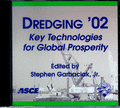Dredging Operations and Environmental Research Program: Building Tools for Objective Determination of Environmental Windows
Publication: Dredging '02: Key Technologies for Global Prosperity
Abstract
Environmental windows have become a prevalent dredging project management practice. Frequently decisions regarding windows are made in the absence of conclusive evidence that dredging does or does not pose a significant threat to specific resources. Windows are often based on a risk-averse approach, which in many cases may be over-restrictive. Given the host of factors that influence dredging-related risk, resource and dredging project managers have been handicapped by a lack of tools and methods for evaluation of the need for protective measures. Recent efforts within the Dredging Operations and Environmental Research (DOER) Program have sought to fill this gap along several fronts: development of models designed to simulate dredging processes; development of enhanced technologies for characterization of dredging-induced perturbations; and development of databases that provide access to relevant data. Among the modeling tools are SSFATE, SSDOSE, and FISHFATE, models that respectively simulate sediment resuspension and dispersion, calculate exposures of aquatic organisms to sediment plumes, and estimate the population dynamics consequences of hydraulic entrainment. The ultimate goal of these development efforts is provision of a complete "toolbox" for use by biological resource and dredging project managers, whereby environmental windows can be evaluated in terms of need and effectiveness. These tools can also be used proactively to predict the likely effects of various dredging project scenarios, such that if windows are justified, their dates can be determined to provide optimal resource protection. SSFATE is a flexible model built on a GIS platform that simulates resuspension by hopper, cutterhead, and bucket dredges. The user customizes the dredging scenario to accommodate best available knowledge of the dredging mode of operation, in situ sediment characteristics, and local bathymetry and flow fields. Output includes particle tracking plume animation in tidal and non-tidal situations and prediction of time series trajectories of suspended sediment concentration at any location in the model domain. In SSDOSE, the user can calculate the hypothetical exposure of various organisms (e.g., sessile bottom invertebrates, passively drifting plankton, adult fishes with directed movement) as they encounter plumes generated in SSFATE. With FISHFATE, the user can place estimated rates of mortality due to hydraulic entrainment into context with other sources of mortality acting upon a given stock, and predict the short and long-term consequences of multiple dredging project scenarios. Each model is capable of examining alternative dredging practices and providing insights into risk minimization via optimal windows.
Get full access to this article
View all available purchase options and get full access to this chapter.
Information & Authors
Information
Published In
Copyright
© 2003 American Society of Civil Engineers.
History
Published online: Apr 26, 2012
Authors
Metrics & Citations
Metrics
Citations
Download citation
If you have the appropriate software installed, you can download article citation data to the citation manager of your choice. Simply select your manager software from the list below and click Download.
